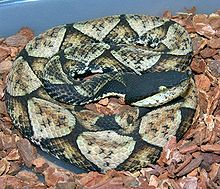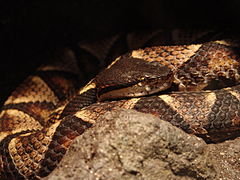- Deinagkistrodon
-
Deinagkistrodon 
Scientific classification Kingdom: Animalia Phylum: Chordata Subphylum: Vertebrata Class: Reptilia Order: Squamata Suborder: Serpentes Family: Viperidae Subfamily: Crotalinae Genus: Deinagkistrodon
Gloyd, 1979Species: D. acutus Binomial name Deinagkistrodon acutus
(Günther, 1888)Synonyms - Ancistrodon - Boulenger, 1896
- Deinagkistrodon - Gloyd, 1979[1]
- Halys acutus - Günther, 1888
- Ancistrodon acutus - Boulenger, 1896
- Agkistrodon acutus - Namiye, 1908
- Deinagkistrodon acutus - Gloyd, 1979[1]
Deinagkistrodon is a monotypic genus[4] created for a venomous pitviper species, D. acutus, found in Southeast Asia.[1] No subspecies are currently recognized.[5]
Contents
Description
Adults grow to an average length of 91–121 cm (36-48 in.),[2] with the largest specimen on record measuring 154.5 cm (61 in.).[6] The head has a pronounced soft "horn" on the snout, the length of which varies. It is because of this rostral appendage that the species is sometimes referred to as a "snorkel viper."[2]
The color pattern consists of a grayish or reddish brown ground color overlaid with a series of brown or reddish brown lateral triangles with grey or beige centers. These join middorsally giving the appearance of alternating triangles of different colors. The head is dark brown on top and beige or pinkish on the sides.[2]
Common names
Sharp-nosed viper, snorkel viper, hundred pacer,[2] Chinese moccasin.[3] Chinese copperhead,[7] five-pacer, hundred-pace snake, long-nosed pit viper, sharp-nosed pit viper,[8] hundred-pace pitviper.[9]
Geographic range
Found in southern China (Chekiang, Fukien, Hunan, Hupeh, Kwantung), Taiwan, northern Vietnam, and possibly Laos. The type locality was not included in the original description. It was later given as "Wusueh [Wu-hsueh], Hupeh Province, China" by Pratt (1892) and Pope (1935). Listed as "Mountains N. of Kiu Kiang" in the catalogue of the British Museum of Natural History.[1]
Habitat
Found on forested mountain slopes, rock-strewn hillsides and brushy valleys.[2] Occurs at elevations between 100 m and 1,400 m.[3]
Behavior
This species is mostly active at night or in the evening and spends the day coiled in sheltering rock ledges, among fallen leaves or bracken, in hollow logs and other places where its color pattern keeps it camouflaged.[2] When encountered it may appear sluggish at first, but it is capable of striking vigorously when threatened.[3]
Feeding
The diet consists of small mammals, birds and frogs.[2]
Reproduction
As one of the few oviparous pit vipers, D. acutus can lay up to 24 eggs, which may be retained during initial incubation—an adaptation that shortens post-deposition incubation time. Hatchlings are lighter and more vividly patterned than the adults, but this darkens considerably with age.[2]
Venom
Dangerous animals often have exaggerated reputations and this species is no exception. The popular name "hundred pacer" refers to a local belief that, after being bitten, the victim will only be able to walk 100 steps before dying. In some areas, it has even been called the "fifty pacer." Nevertheless, this species is considered dangerous, and fatalities are not unusual. An antivenom is produced in Taiwan.[2]
Brown (1973) mentions a venom yield of up to 214 mg (dried) and LD50 (toxicity) values of 0.04 mg/kg IV, 4.0 mg/kg IP and 9.2-10.0 mg/kg SC.[10]
According to the US Armed Forces Pest Managent Board, the venom is a potent hemotoxin that is strongly hemorrhagic. Bite symptoms include severe local pain and bleeding that may begin almost immediately. This is followed by considerable swelling, blistering, necrosis, and ulceration. Systemic symptoms, which often include heart palpitations, may occur suddenly and relatively soon after the bite.[3] Because of its body size and large hinged fangs which permit effective delivery of large quantities of venom, victims bitten by this snake should be treated accordingly.
In popular culture
The snake is also sold as a meal in some Taiwanese restaurants, served with the venom as a drink, pills floating in both the drink and in the snake. The pills are said to counteract the venom.
See also
- List of crotaline species and subspecies
- Crotalinae by common name
- Crotalinae by taxonomic synonyms
- Snakebite
References
- ^ a b c d McDiarmid RW, Campbell JA, Touré T. 1999. Snake Species of the World: A Taxonomic and Geographic Reference, vol. 1. Herpetologists' League. 511 pp. ISBN 1-893777-00-6 (series). ISBN 1-893777-01-4 (volume).
- ^ a b c d e f g h i j Mehrtens JM. 1987. Living Snakes of the World in Color. New York: Sterling Publishers. 480 pp. ISBN 0-8069-6460-X.
- ^ a b c d e Deinagkistrodon acutus at Armed Forces Pest Managent Board. Accessed 30 May 2007.
- ^ "Deinagkistrodon". Integrated Taxonomic Information System. http://www.itis.gov/servlet/SingleRpt/SingleRpt?search_topic=TSN&search_value=634413. Retrieved 3 November 2006.
- ^ "Deinagkistrodon acutus". Integrated Taxonomic Information System. http://www.itis.gov/servlet/SingleRpt/SingleRpt?search_topic=TSN&search_value=634883. Retrieved 3 November 2006.
- ^ Gloyd HK, Conant R. 1990. Snakes of the Agkistrodon Complex: A Monographic Review. Society for the Study of Amphibians and Reptiles. 614 pp. 52 plates. LCCN 89-50342. ISBN 0-916984-20-6.
- ^ Gotch AF. 1986. Reptiles -- Their Latin Names Explained. Poole, UK: Blandford Press. 176 pp. ISBN 0-7137-1704-1.
- ^ U.S. Navy. 1991. Poisonous Snakes of the World. US Govt. New York: Dover Publications Inc. 203 pp. ISBN 0-486-26629-X.
- ^ Gumprecht A, Tillack F, Orlov NL, Captain A, Ryabov S. 2004. Asian Pitvipers. GeitjeBooks Berlin. 1st Edition. 368 pp. ISBN 3-937975-00-4.
- ^ Brown JH. 1973. Toxicology and Pharmacology of Venoms from Poisonous Snakes. Springfield, Illinois: Charles C. Thomas. 184 pp. LCCCN 73-229. ISBN 0-398-02808-7.
External links
- Deinagkistrodon acutus at the Reptarium.cz Reptile Database. Accessed 6 August 2007.
- Video of Deinagkistrodon acutus on YouTube. Accessed 6 August 2007.
Categories:- Crotalinae
- Reptiles of China
- Fauna of Taiwan
- Fauna of Vietnam
- Monotypic reptile genera
- Reptiles of Malaysia
Wikimedia Foundation. 2010.


